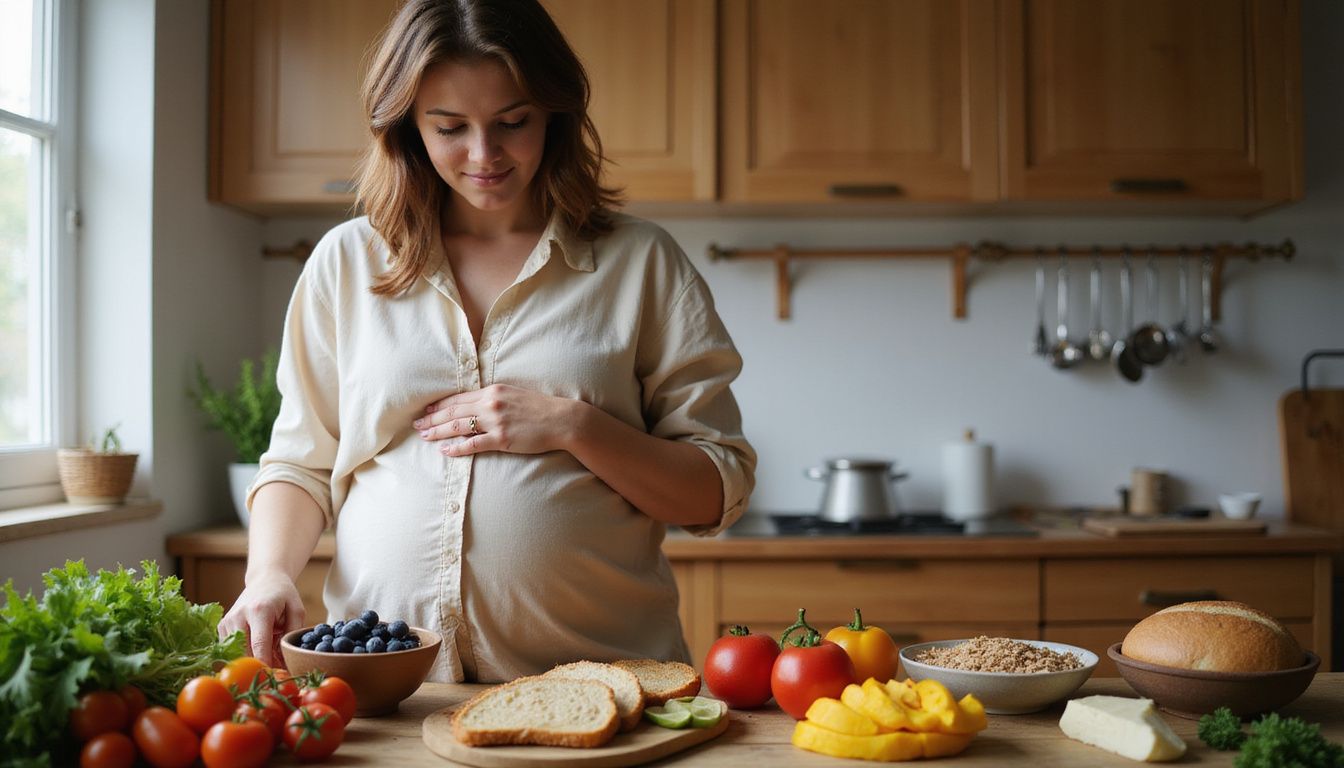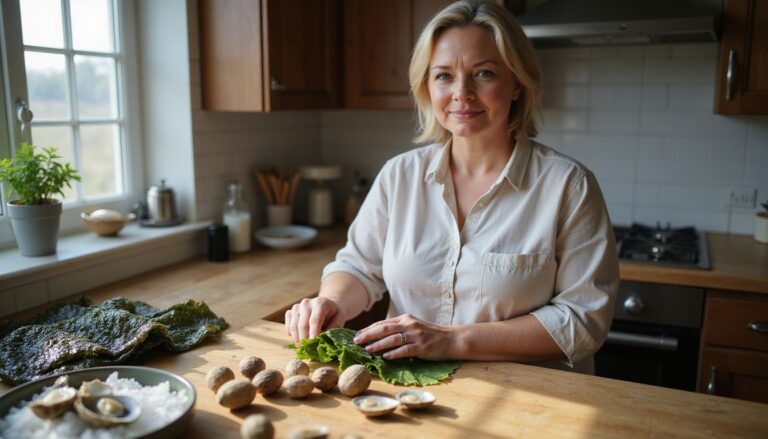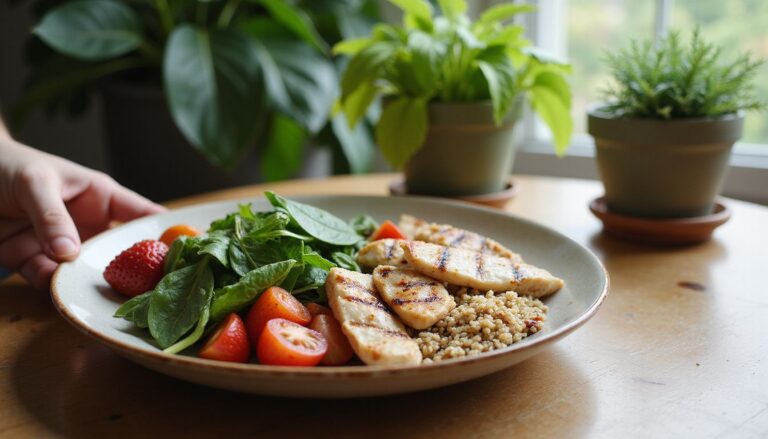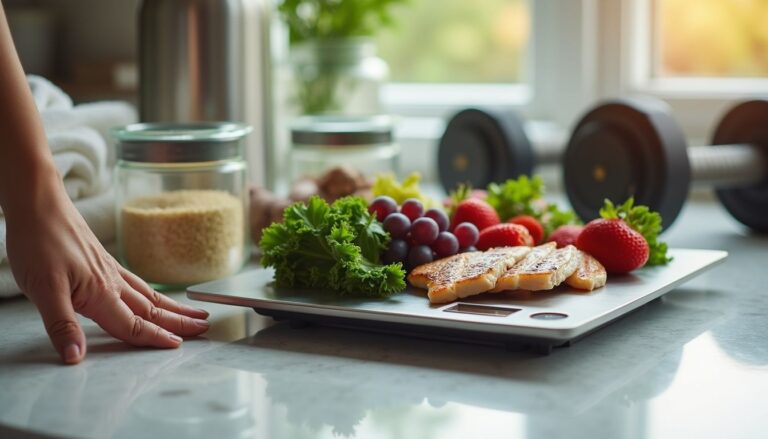Ultimate Pregnancy Meal Plan For Healthy Eating And Nutrient-Rich Diet
Our Nutrition Assistant AI Suite will transform your body. You will lose fat, get toned, and build muscle. Gain confidence and optimal health.
Building a pregnancy meal plan can feel tricky at first. Your body needs extra energy and key nutrients to support growth. A clear plan helps you meet goals without stress, and it keeps your healthy diet on track.
Experts note that your needs rise for folate, iron, calcium, vitamin D, and protein. This guide gives you simple meal ideas, quick recipes with nutrition facts, and smart tips for each trimester. You will see how to eat well and support your baby’s development while caring for your own health, so keep reading for practical steps you can use today.
Key Takeaways
- Most pregnant women need about 300 to 450 extra calories per day in the second and third trimesters, based on ACOG and USDA guidance updated in 2024.
- Folate or folic acid, iron, calcium, vitamin D, and protein are essential for fetal growth and your health. Targets include 400 micrograms folate or more, 27 milligrams iron, 1,000 milligrams calcium, 600 IU vitamin D, and about 71 grams protein daily.
- Build balanced meals with whole grains, lean protein such as poultry or low mercury seafood, dairy or fortified alternatives, legumes, fruits, vegetables, nuts, and healthy fats.
- Sample recipes can help you hit targets, for example Egg Wraps with 26.2 grams protein or Stuffed Acorn Squash with 7.5 milligrams iron per serving.
- Skip unpasteurized dairy and high mercury fish to reduce foodborne illness risk. Talk with your healthcare provider before making major changes.

What are the nutrition basics for pregnancy?

Eating well during pregnancy gives your baby nutrients for growth and development. It also supports your strength, mood, and energy. You will need more calories and more vitamins and minerals than before pregnancy.
Most experts, including the United States Department of Agriculture and the Department of Health and Human Services, recommend following evidence-based tools like MyPlate or the Dietary Guidelines for Americans. These frameworks are simple and practical. They steer you toward fruits, vegetables, whole grains such as brown rice or oats, lean meat and poultry, fish low in mercury such as salmon or herring, yogurt or hard cheese, eggs as a source of protein, beans, and lentils.
Focus on variety at each meal to cover your bases. Try fortified breakfast cereals that are rich in iron during pregnancy, dark leafy greens high in folate, calcium-rich foods like milk or cheddar cheese, safe seafood for vitamin D, and healthy fats from seeds and vegetable oils. Nuts with fruit can be a steady mid-morning snack that limits added sugar. Keep saturated fat lower by swapping fried sides for roasted vegetables.
ACOG notes that calorie needs often rise by about 300 to 450 calories daily in later trimesters. The exact number depends on your body and activity level. Ask your healthcare provider what fits your situation.
A well balanced diet supports your health and your baby’s prenatal development.
Next, see which nutrients matter most and how to include them from week to week.
Essential nutrients for a healthy pregnancy
Your needs for some nutrients go up during pregnancy. Knowing which ones to target makes meal planning easier and helps you meet daily goals.
What are the benefits of folate and folic acid during pregnancy?
Folate is the natural form of vitamin B9 found in food. Folic acid is the synthetic form used in fortified foods and supplements. Both help form new cells and protect the neural tube, the early brain and spinal cord, from defects.
Guides like Harvard’s Healthy Eating Plate and USDA’s MyPlate encourage foods rich in folate and fortified products with folic acid. Simple meal ideas can add up fast. Classic Apple Cinnamon Overnight Oats provide 47.7 micrograms per serving, and an Egg Wrap supplies 123.6 micrograms. The Fiesta Salad in this plan offers about 415.8 micrograms per serving. A Colorful Crab Salad Sandwich adds 87.6 micrograms of natural folate. These choices help you reach the recommended daily intake.
Why is iron important for pregnant women?
Iron helps your body make red blood cells that carry oxygen. During pregnancy, your blood volume grows and your iron needs increase. Low iron can lead to anemia, which may cause fatigue and put you and your baby at risk.
Iron rich meals make a difference. Stuffed acorn squash delivers 7.457 milligrams of iron per serving. Egg Cellent Veggie and Hummus Pita supplies 5.154 milligrams. Loaded Pesto Veggie Burgers give 3.905 milligrams, and Cashew Trail Mix adds 2.36 milligrams. If you often feel tired, include iron sources at most meals and pair them with produce rich in vitamin C, such as bell peppers or oranges, to boost absorption.
What are the best sources of calcium for pregnancy?
Calcium supports strong bones and teeth for you and your baby. MyPlate recommends about 3 cups of dairy or fortified alternatives per day. Classic Apple Cinnamon Overnight Oats provide 560.1 milligrams per serving, and a Crunchy Pumpkin Spice Parfait offers 552.2 milligrams.
A Blueberry Almond Smoothie adds about 271.2 milligrams. Cheese with crackers gives around 133.2 milligrams per portion. A pizza and salad meal contributes roughly 316 milligrams. If you do not use dairy, choose fortified soy milk or other plant drinks labeled fortified. Leafy greens like collards and bok choy help too, though they usually provide less calcium per serving.
How does vitamin D support pregnancy health?
Vitamin D helps you absorb calcium and supports skeletal development. It also plays a role in immune health. Aim for 1 to 2 servings of dairy or fortified foods daily, or as advised by your provider.
Parmesan Chicken Tenders with Marinara contain about 0.312 micrograms of vitamin D per serving, and an Egg Wrap provides 0.438 micrograms. Fortified orange juice can help fill gaps. Some recipes, such as Classic Apple Cinnamon Overnight Oats, may not include vitamin D, so plan to add fortified items elsewhere in your day.
How much protein do pregnant women need?
Protein builds your baby’s tissues and supports your own. Most experts recommend at least 71 grams per day during pregnancy. Spread protein across meals and snacks to make it easier to meet your goal.
Examples include Parmesan Chicken Tenders with 50.9 grams of protein per serving, Egg Wraps with 26.2 grams, and Fiesta Salad with 27.4 grams. Snacks can help too. A Crunchy Pumpkin Spice Parfait adds 20.7 grams, and a Blueberry Almond Smoothie provides about 6.878 grams.
Which foods provide healthy fats for pregnancy?
Healthy fats support brain and eye development. Good options include nuts, seeds, seafood, and dairy. Cashew Trail Mix has 8.675 grams of fat per serving. A Blueberry Almond Smoothie supplies 9.478 grams. Egg Wraps have about 21.2 grams per portion.
Pork and Pineapple Kebobs add 19.2 grams of fat, and a Loaded Pesto Veggie Burger contains 22.2 grams. Choose sources with more unsaturated fats, such as olive oil and avocado. Keep saturated fat modest, and follow your provider’s advice if you have a specific target.
Caloric needs during pregnancy stages
Your calorie needs change across trimesters. A simple plan keeps you fueled without guessing.
How many calories are needed in early pregnancy?
In the first trimester, most people do not need extra calories. ACOG notes that you can usually keep your pre pregnancy intake. The MyPlate Plan sets a target using your age, height, pre pregnancy weight, activity level, and trimester.
Focus on quality. Choose whole grains like brown bread or whole grain pasta, colorful produce, and protein from poultry, eggs, tofu, or beans. Low fat or fat free dairy helps you meet calcium needs without adding too many calories. Many people feel better when they improve diet quality early, even if the total calories stay about the same.
Why do calorie needs increase in mid-pregnancy?
During the second trimester, your body supports rapid growth and a higher blood volume. ACOG suggests an extra 340 calories per day in this stage.
Use small, steady additions. A boiled egg, a slice of whole grain bread, yogurt, or nuts can help you meet the goal with nutrient dense choices. If hunger rises, add a snack with protein and fiber to keep energy stable through the day.
What are the calorie requirements in late pregnancy?
In the third trimester, needs rise to about 450 extra calories per day, according to ACOG. If you are pregnant with twins, aim for around 600 more. With triplets, needs can increase by up to 900 extra calories daily.
Steady weight gain of about one pound per week often shows you are meeting energy needs. Add more whole grains, lean protein such as eggs or soybeans, and healthy fats like nuts and avocado. A small afternoon snack, for example yogurt with fruit or cheese and crackers, can help you reach targets without feeling overly full at dinner.
Comprehensive meal plan ideas for pregnancy
A balanced pregnancy meal plan keeps you nourished and supports growth. Mix and match the ideas below to cover key nutrients, taste, and convenience.
What are healthy breakfast options for pregnancy?
Start with protein, calcium, fiber, and whole grains. These choices support stable energy and digestion.
- Classic apple cinnamon overnight oats offer 448.3 calories, 19.6 grams protein, 65.3 grams carbs, 9.1 grams fiber, and 560.1 milligrams calcium.
- Egg wraps with fresh vegetables provide 453.4 calories, 26.2 grams protein, 44 grams carbs, and 6.8 grams fiber.
- A pear and cheese breakfast sandwich delivers 447.5 calories, 15.1 grams protein, 64.5 grams carbs, 12.6 grams fiber, and 314.7 milligrams calcium.
- Crunchy pumpkin spice parfaits give about 455 calories, more than 20 grams protein, over 6 grams fiber, and 552 milligrams calcium per serving.
- Bacon and egg frittata is lighter at about 184 calories per serving with roughly 16 grams protein.
- Use whole grains like wheat bread or corn tortillas to raise fiber for easier digestion.
- Choose only pasteurized dairy to reduce the risk from unpasteurized products.
Once you have your staples, move into quick recipes you can prep ahead.
How to make apple-cinnamon overnight oats?
Apple cinnamon overnight oats offer a quick make ahead breakfast with steady energy.
- Measure 1/2 cup rolled oats into a jar or bowl for fiber and complex carbs.
- Pour in 1 cup low fat milk or fortified plant milk to provide about 560 milligrams calcium per serving.
- Add half a diced apple for natural sweetness and vitamin C.
- Stir in 1/4 teaspoon cinnamon. Cinnamon is safe in normal food amounts.
- Mix in 1 tablespoon chia seeds to add omega 3 fats and more fiber.
- Sprinkle chopped walnuts if desired for healthy fats and crunch.
- Refrigerate overnight so the oats soften and the flavors blend.
- Enjoy cold or warm gently using steam or the stove.
This bowl gives about 448 calories, almost 20 grams protein, and over 9 grams fiber. It supports folate, iron, and calcium needs throughout pregnancy.
What is an egg wrap with fresh vegetables recipe?
This wrap pairs protein rich eggs with colorful vegetables and calcium.
- Whisk two large eggs with a pinch of salt, then pour into a nonstick skillet over medium heat.
- Cook until set, flip, and form a flat wrap.
- Layer sliced bell peppers, spinach, shredded carrots, and diced tomato down the center.
- Add reduced fat shredded cheese or cottage cheese for about 353.8 milligrams calcium.
- Fold both sides over the filling while warm.
- Each serving delivers 26.2 grams protein to support growth.
- Add avocado slices for healthy fats that aid vitamin absorption.
- One serving provides 453.4 calories, 44 grams carbs, and 6.86 grams fiber.
- Use a small drizzle of olive oil mayonnaise if desired. Avoid raw egg based sauces.
- Serve right away or wrap for a portable meal that does not rely on soda or excess caffeine.
Rotate this with the pear and cheese sandwich below to add variety to your mornings.
How to prepare a pear and cheese morning sandwich?
This sweet savory sandwich offers fiber, calcium, and protein in minutes.
- Wash and thinly slice one ripe pear.
- Choose one ounce mozzarella or Swiss for calcium and protein.
- Toast two slices of whole grain bread to boost fiber to about 12.6 grams per serving.
- Layer pear slices on one slice of bread, then add cheese.
- Drizzle a teaspoon of honey or dust with cinnamon for gentle sweetness. Keep added sugar near 23.2 grams per serving.
- Top with the second slice and press gently.
- Grill over medium heat for about two minutes per side until the cheese melts.
- Serve with leafy greens or a handful of walnuts for extra healthy fats and choline.
This quick breakfast can keep you full through busy errands while supporting your nutrition targets.
What are nutritious lunch suggestions for pregnancy?
Lunch is a great time to load up on vegetables, protein, and fiber. These options offer balanced macros and key minerals.
- Egg Cellent Veggie and Hummus Pita gives 553.8 calories, 22.4 grams protein, 81.1 grams carbs, and 9.96 grams fiber.
- Colorful Crab Salad Sandwich delivers 564.4 calories and 33.2 grams protein, with omega 3s that support brain development.
- Fiesta Salad supplies 542.7 calories, 27.4 grams protein, and 20.7 grams fiber per serving.
- Loaded Pesto Veggie Burger provides 549.1 calories and a plant based iron boost.
- Panera Bread You Pick Two is about 550 calories, with 29 grams protein and more than 72 grams carbs.
- Build on whole grain wraps or brown rice bowls for steady energy.
- Rotate dark greens like spinach or kale for folate.
- Include low mercury seafood such as salmon once per week to add DHA.
- Avoid unpasteurized dairy products in dressings or toppings.
Change up your lunch choices every few days to cover more nutrients and prevent boredom.
How to make a vegetable and hummus pita?
This pita packs color, crunch, and staying power in one handheld meal.
- Wash and chop bell peppers, cucumbers, shredded carrots, and cherry tomatoes.
- Spread three tablespoons hummus inside a whole wheat pita pocket.
- Fill the pita with the vegetables to reach about 9.963 grams fiber per serving.
- Add spinach or arugula to increase calcium to around 104.6 milligrams.
- Sprinkle feta or mozzarella for flavor. Use only pasteurized cheese.
- Drizzle with olive oil for about 18.5 grams of healthy fat per serving.
- Season lightly with pepper or herbs to manage sodium, which is about 620.7 milligrams per serving.
- Pair with water or milk for hydration and extra calcium.
- Serve right away for peak freshness and crunch.
Bright, crunchy pitas can help you skip fast food and still feel satisfied.
What is a fresh crab salad sandwich recipe?
This sandwich brings protein and safe seafood together in one simple build.
- Use 3 ounces cooked crab meat, which is a low mercury seafood.
- Mix crab with 1 tablespoon light mayonnaise, diced celery, and lemon juice.
- Add chopped parsley or dill for flavor.
- Place romaine on whole grain bread to add fiber.
- Spoon the crab mixture onto the bread and close the sandwich.
- Serve with sliced tomatoes or cucumber for hydration and vitamins.
- Each serving provides about 564 calories, 33 grams protein, nearly 70 grams carbs, and around 12 grams fiber, with about 2 grams saturated fat.
- You also get about 183 milligrams calcium and over 6 milligrams iron.
- Use only pasteurized dairy if adding cheese to the sandwich.
The ingredient list follows FDA and CDC safety guidance for pregnancy friendly seafood and dairy.
How to prepare a colorful fiesta salad?
Fresh flavors and bold colors make this salad a go to lunch.
- Gather red bell peppers, cherry tomatoes, corn, black beans, and spinach. Black beans supply protein and fiber.
- Slice one avocado for healthy fats, vitamin E, and potassium.
- Add 1/2 cup shredded cheddar for calcium and protein. This brings the calcium to about 360 milligrams per serving.
- Use cilantro and lime juice for flavor without added sugar or salt.
- Sprinkle pumpkin seeds for crunch and an iron boost to meet the 5.411 milligrams target per serving.
- Toss with olive oil to reach about 21.4 grams fat per serving.
- Serve chilled or at room temperature. One serving provides around 542 calories, 27 grams protein, nearly 67 grams carbs, and almost 21 grams fiber.
Whole food ingredients help you hit your goals while avoiding high mercury fish and unpasteurized items.
What are healthy dinner ideas for pregnancy?
Evening meals should cover protein, fiber, vitamins, and minerals. These options fit well in a weekly rotation.
- Savory stuffed acorn squash offers 641.7 calories, 23.6 grams protein, 110.2 grams carbs, and 16.2 grams fiber.
- Crispy parmesan chicken tenders with marinara pack 649.2 calories, 50.9 grams protein, 69.6 grams carbs, and 10.7 grams fiber.
- Zesty pork and pineapple kebobs provide 640.6 calories, 35.6 grams protein, 86.8 grams carbs, and 15.2 grams fiber.
- Pizza with a side salad adds variety with about 640.4 calories and 21.1 grams protein.
- Healthier nachos with lean meat or beans offer 656.8 calories, 36.9 grams protein, and nearly 12 grams fiber.
- Include roasted vegetables or steamed greens for more vitamins C and K.
- Drink water or low fat milk to support daily hydration goals.
Hearty protein at dinner can help you feel satisfied and meet iron targets.
How to make savory stuffed acorn squash?
This hearty dish is full of fiber, color, and plant protein.
- Preheat oven to 400°F.
- Halve two acorn squashes and scoop out seeds.
- Drizzle cut sides with olive oil and sprinkle with salt.
- Place cut side down on a parchment lined tray.
- Roast 30 to 40 minutes until tender.
- Sauté 1 cup chopped onions, 1 cup diced bell peppers, and 2 cloves minced garlic until soft.
- Stir in 1 cup cooked brown rice or quinoa and 1/2 cup canned black beans.
- Season with 1 teaspoon ground cumin, plus salt and pepper to taste.
- Fill each squash half with the mixture and top with shredded cheese if desired.
- Bake at 375°F for 10 minutes until warmed through.
- Serve with steamed broccoli or a salad. One serving provides about 7.457 milligrams iron and 198.2 micrograms folate.
This recipe makes a complete plate with grain, vegetables, and protein.
What is a recipe for crispy parmesan chicken tenders?
These baked tenders give you crispy texture without deep frying.
- Preheat oven to 425°F.
- Slice boneless, skinless chicken breasts into strips.
- Whisk one egg with a splash of water in a shallow dish.
- In a second dish, mix 1 cup whole wheat breadcrumbs with 1/2 cup grated parmesan for extra flavor and about 231.4 milligrams calcium per serving.
- Dip chicken in egg, then coat with the breadcrumb parmesan mixture.
- Place strips on a parchment lined baking sheet.
- Bake 20 minutes or until golden and cooked through. The center should reach 165°F.
- Serve with a side salad or roasted vegetables for added fiber.
- Each serving has about 50.9 grams protein, 22.8 grams fat with around 4 grams saturated fat, 10.7 grams fiber, 3.68 milligrams iron, 1171 milligrams sodium, 92.5 milligrams cholesterol, and 86.5 micrograms folate.
Pair with marinara for a simple dip and extra flavor.
How to prepare zesty pork and pineapple kebobs?
These kebobs balance sweet fruit, lean meat, and colorful vegetables.
- Cut 1 pound lean pork into 1 inch cubes for about 35.6 grams protein per serving.
- Peel and cube 1 cup fresh pineapple for vitamin C and natural sweetness.
- Chop red bell pepper, onion, and zucchini into bite size pieces.
- Mix 2 tablespoons olive oil with 1 tablespoon lemon juice. Add 1 teaspoon each garlic powder and paprika.
- Toss pork, vegetables, and pineapple in the marinade. Let sit at least 20 minutes.
- Thread ingredients onto skewers, alternating as you go.
- Grill over medium high heat for 10 to 12 minutes, turning until the pork is cooked through.
- Serve with brown rice or quinoa to reach about 86.8 grams carbs per serving.
- Each serving has about 640.6 calories, 19.2 grams fat with roughly 3.429 grams saturated fat, 75.1 milligrams calcium, 4.212 milligrams iron, and 101.5 micrograms folate.
This dish supports protein needs and adds variety to your weekly rotation.
What are good snack choices during pregnancy?
Smart snacks fill gaps and steady your energy between meals.
- Cheese and crackers give protein and carbs. One serving has about 202.2 calories, 7.205 grams protein, 24.8 grams carbs, and 3.017 grams fiber.
- Crunchy granola with yogurt supports calcium and gut health. One cup has roughly 198.7 calories, 15.7 grams protein, 25.2 grams carbs, and 2.002 grams fiber.
- Blueberry almond smoothies add antioxidants and healthy fats. Each has around 202.5 calories, 6.878 grams protein, 25.6 grams carbs, and 5.758 grams fiber.
- Smores Luna Bars are portable, with about 190 calories and 8 grams protein per bar.
- Parmesan and black pepper popcorn is light yet filling. One serving has about 208.4 calories, 8.357 grams protein, 30.5 grams carbs, and over 6 grams fiber.
- Sliced vegetables with hummus add crunch, vitamins, and plant protein.
- Frozen yogurt pops make a cool treat and add calcium.
Choose snacks with protein and fiber to stay satisfied longer.
How to serve cheese and crackers as a snack?
This classic combo is quick, portable, and easy to portion.
- Pick whole grain crackers for about 24.8 grams carbs and 3 grams fiber per serving.
- Use pasteurized cheddar or mozzarella for safety.
- Slice cheese into small pieces. Each serving adds about 7 grams protein, 8 grams fat, and 133 milligrams calcium.
- Arrange on a plate so portions stay clear.
- Add apple or pear slices for fiber and vitamin C while keeping total near 202 calories.
- Pair with water or low fat milk for hydration and extra calcium.
- Refrigerate leftovers in an airtight container.
What is a blueberry almond smoothie recipe?
When you want something cool and gentle on the stomach, this smoothie is a great choice.
- Gather 1 cup blueberries, 1 tablespoon almond butter, 1 cup low fat milk or calcium fortified plant milk, 1/2 banana, and a handful of spinach.
- Place everything in a blender. A ripe banana adds sweetness without added sugar.
- Blend on high until smooth and creamy.
- Pour into a glass. This recipe makes one serving at about 202.5 calories.
- Each serving has about 6.9 grams protein, 25.6 grams carbs, and 5.8 grams fiber.
- You get around 9.5 grams fat with about 1 gram saturated fat.
- Minerals include roughly 271 milligrams calcium, about 1.8 milligrams iron, and 25 micrograms folate.
- Drink while cold. Top with sliced almonds for crunch if you like.
- If mornings are tough, sip this slowly to keep nausea down.
- Adjust thickness with more milk or ice. Swap in Greek yogurt to boost protein further.
This blend supports bone health, digestion, and steady energy.
How to enjoy fresh hummus with vegetables?
Hummus with raw vegetables is a savory snack that is easy to prep.
- Choose carrot sticks, cucumber rounds, bell pepper strips, or cherry tomatoes.
- Use about two tablespoons hummus per serving for around 70 calories and 2 grams protein.
- Plate the vegetables next to your hummus for easy dipping.
- Pick lower sodium hummus if you can, often under 200 milligrams per serving.
- For more fiber, dip with whole wheat crackers or raw broccoli florets.
- Use colorful choices, like purple carrots or green snap peas, to cover a range of nutrients.
- Drink water or herbal tea with your snack.
- For added calcium, sprinkle a little shredded cheese over your veggies.
- Most servings land near 210 calories, which fits a balanced plan.
What are sweet but healthy treat alternatives?
Cravings are common. Choose treats that satisfy taste and still support your goals.
- One ounce dark chocolate has 168 calories, 2 grams protein, 13 grams carbs, 3 grams fiber, and 12 grams fat.
- Yasso Sea Salt Caramel Frozen Greek Yogurt Pops provide 100 calories, 5 grams protein, and 0.5 gram fat per pop.
- Smartfood White Cheddar Popcorn delivers 160 calories per ounce and a satisfying crunch.
- Creamy strawberry mousse made with skim milk or low fat Greek yogurt has about 132 calories and 8 grams protein.
- Fresh fruit, like pears or apples with mild cheese, gives natural sweetness plus calcium.
- Blend frozen berries with almond milk. Add yogurt for an extra 6 to 8 grams of protein.
- Make frozen yogurt pops at home with low fat yogurt and fruit puree, often under 120 calories per serving.
- For a classic cookie fix, one Nestle Toll House chocolate chip cookie has about 90 calories and 4 grams fat.
- Strawberries dipped in dark chocolate feel special yet still bring vitamins from the fruit.
Keep portions small and enjoy treats slowly so a little goes a long way.
How to enjoy rich dark chocolate safely?
Dark chocolate can fit a healthy plan when you mind the portion and ingredients.
- Pick at least 70 percent cocoa for more antioxidants and less sugar.
- Limit to one ounce. That serving has 168 calories, 2 grams protein, 13 grams carbs, and 3 grams fiber.
- Watch total fat. One ounce contains 12 grams fat including 7 grams saturated fat.
- Check labels for sodium, often about 6 milligrams per ounce.
- Pair it with fresh fruit or unsalted nuts for balance.
- Avoid products made with alcohol or unpasteurized cream.
- Discuss allergies or special needs with your provider if unsure.
- Eat slowly to enjoy the flavor and feel satisfied.
- Use dark chocolate as an occasional treat rather than a daily habit.
A small square after lunch can calm a craving without throwing off your daily goals.
What are creamy frozen yogurt pops recipes?
Frozen yogurt pops offer protein, calcium, and a cool finish to a meal.
- Mix 1 cup Greek yogurt with 1 tablespoon honey and 1/2 teaspoon vanilla.
- Stir in chopped fruit such as strawberries, blueberries, or mango.
- Pour into popsicle molds and freeze for at least 4 hours.
- For a ready made option, Yasso Sea Salt Caramel Pops have 100 calories, 5 grams protein, 18 grams carbs, 16 grams sugar, and 0.5 gram fat.
- Sprinkle in chia seeds before freezing for fiber and omega 3 fats.
- Top with a bit of low sugar granola before inserting sticks for crunch.
- Switch between plain, vanilla, or berry yogurt to keep flavors fresh.
These pops satisfy a sweet tooth, and they help meet calcium and protein needs.
How to plan meals strategically during pregnancy
Simple planning turns good intentions into daily habits. Think of your plate as a short checklist you can repeat.
Why choose diverse foods for pregnancy nutrition?
Eating a range of foods helps you cover more vitamins and minerals. MyPlate and Harvard’s Healthy Eating Plate suggest filling half your plate with fruits and vegetables, one quarter with whole grains, and one quarter with healthy proteins such as poultry, eggs, beans, or tofu.
Leafy greens provide folate, dairy or fortified plant milk offers calcium, and lean meats and spinach supply iron. Swapping white rice for brown rice or quinoa adds fiber. Cutting back on processed meats can reduce sodium. Aim for a rainbow of produce through the week so each meal brings something new.
How to include whole grains and fresh vegetables?
Whole grains and vegetables form the base of a strong pregnancy diet. Small swaps add up fast.
- Choose whole grain bread, pasta, or rice at least half the time. MyPlate suggests making at least half your 7 ounce grain target whole.
- Start mornings with oats, bran flakes, or quinoa porridge.
- Add spinach or kale to sandwiches, wraps, scrambles, or smoothies.
- Serve about 3 cups of vegetables daily as soups, salads, stir fries, or sides.
- Snack on sliced peppers, carrots, cucumbers, or cherry tomatoes with hummus.
- Roast broccoli, sweet potatoes, cauliflower, or squash with herbs for dinner.
- Blend berries into yogurt parfaits or top cereal with banana to reach 2 cups of fruit daily.
These habits help you meet fiber and micronutrient goals with food you enjoy.
How much hydration is needed during pregnancy?
Fluids support digestion, blood volume, and amniotic fluid. Many providers suggest 8 to 12 cups of water daily, which is 64 to 96 ounces, adjusted for activity and climate.
Coffee and tea can count in moderation. A reusable bottle makes sipping through the day easier. Being well hydrated can help relieve headaches and constipation, and it supports energy and focus.
What foods should be avoided during pregnancy?
Some foods raise the risk of infection or mercury exposure. A short safety list makes daily choices easier.
Why avoid high-mercury fish while pregnant?
Mercury is a metal that can harm a developing brain and nervous system. It builds up in certain fish such as shark, swordfish, king mackerel, and tilefish. Eating these can raise the risk of learning and attention problems later.
The FDA recommends low mercury choices including salmon, tilapia, cod, herring, and crab. Seafood also provides protein and healthy fats. Many people enjoy salmon twice a week for its omega 3s while staying within safety guidelines.
What are the risks of unpasteurized dairy in pregnancy?
Unpasteurized milk and cheese can carry bacteria such as Listeria, Salmonella, and E. coli. The CDC warns that pregnant people have a higher risk of severe illness from these germs.
Infection can lead to miscarriage, preterm delivery, or serious newborn illness. Check labels on milk, yogurt, and soft cheeses like queso fresco, feta, brie, and camembert. Choose only clearly labeled pasteurized products.
Summary:
- Unpasteurized dairy can contain harmful bacteria.
- Pregnant people are more vulnerable to complications.
- Follow CDC advice and pick pasteurized dairy every time.
Why stay away from raw or undercooked foods?
Raw or undercooked seafood, meat, poultry, and eggs raise the risk of foodborne illness. The immune system changes during pregnancy, which makes infections harder to fight. Cooking to safe temperatures kills harmful bacteria like Salmonella and Listeria.
Avoid raw sprouts and heat deli meats or hot dogs to 165°F before eating. These steps lower the risk of food poisoning, which can be more severe in pregnancy. If you are unsure, ask your provider or check FDA food safety guidance.
How can supplements support pregnancy nutrition?
Supplements can fill gaps when food alone does not meet your targets. Always talk with your healthcare provider before starting any supplement during pregnancy.
What are the essentials of prenatal vitamins?
Prenatal vitamins deliver key nutrients in one daily dose. Most contain folate or folic acid to help prevent birth defects, iron to support oxygen transport, calcium for bones, and vitamin D to aid calcium absorption.
Common amounts include at least 400 micrograms folic acid, 27 milligrams iron, 1,000 milligrams calcium, and 600 IU vitamin D per day. Taking your prenatal with food can reduce stomach upset. Your provider can help you choose a brand and adjust amounts if needed.
How do omega-3 fatty acids benefit pregnancy?
Omega 3 fats such as DHA and EPA support brain and eye development. They may also lower the chance of preterm birth.
You can get omega 3s from low mercury seafood like salmon or sardines, and from plant sources like chia seeds and walnuts. Classic Apple Cinnamon Overnight Oats in this guide provide about 1.43 grams of omega 3s when made with chia seeds. Aim for two servings of low mercury seafood per week, or discuss supplements with your provider if you do not eat fish.
Conclusion
A thoughtful pregnancy meal plan helps you meet higher nutrient needs and steady your energy. Balanced meals and snacks support your baby’s growth and help you feel your best from trimester to trimester.
Use guidance from trusted sources such as ACOG, the USDA, the FDA, and the CDC to shape daily choices. The recipes and tips here make healthy eating practical for a busy life. Talk with your healthcare provider about your calorie needs, supplements, and any special concerns. Building strong habits now supports long term health for you and your baby.
FAQs
1. What are the main nutrients needed in a pregnancy meal plan for healthy eating and a nutrient-rich diet?
A balanced pregnancy meal plan should include protein, calcium, iron, folate, vitamin D, and fiber. These nutrients support fetal growth and maternal health. For example, lean meats provide protein; dairy offers calcium; leafy greens supply folate.
2. How can I ensure my daily meals meet recommended nutritional needs during pregnancy?
Plan each meal to include whole grains, fruits or vegetables, lean proteins like poultry or beans, and low-fat dairy products. The American College of Obstetricians and Gynecologists suggests pregnant women need about 27 milligrams of iron per day along with 600 micrograms of folic acid.
3. Are there foods I should avoid while following a nutrient-rich diet during pregnancy?
Avoid raw fish such as sushi made from tuna species high in mercury; unpasteurized cheeses like brie or feta; deli meats unless heated until steaming hot; and undercooked eggs due to risk of foodborne illness.
4. Can you share an example of how someone used a structured meal plan for better nutrition during pregnancy?
One expectant mother shared that using weekly menus helped her track servings from each food group. She noticed improved energy levels after adding more leafy greens for extra folate and switching to fortified cereals for added iron content.
Summary: A well-planned pregnancy diet focuses on key nutrients through varied foods while avoiding certain risks linked to unsafe items. Tracking intake helps maintain balance throughout gestation according to expert guidelines.







